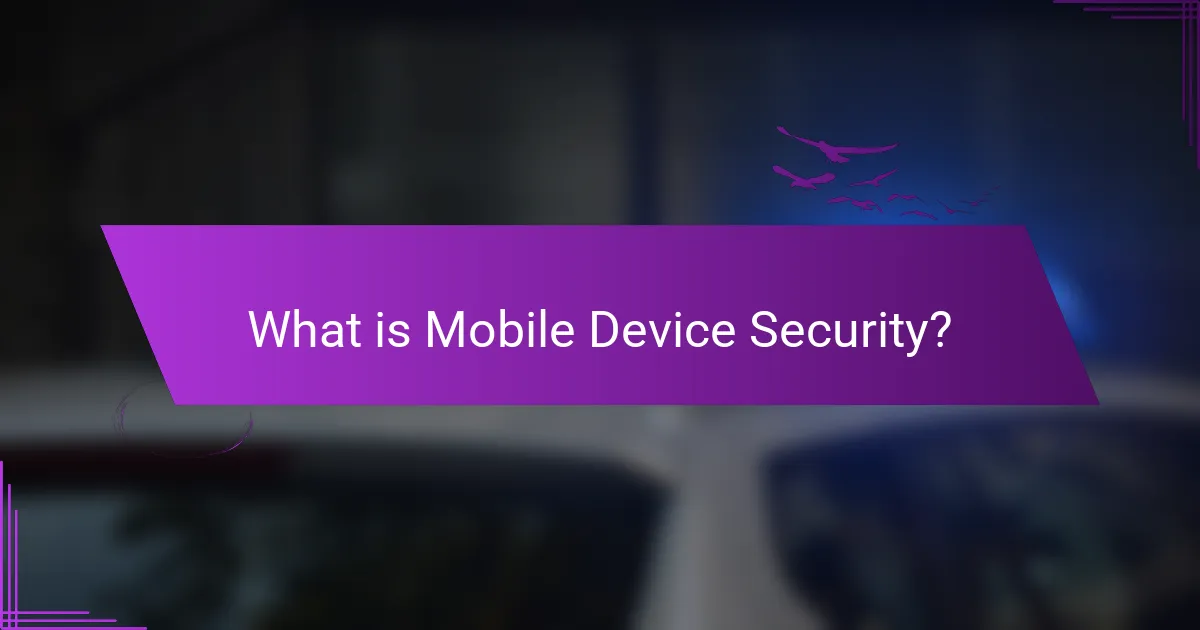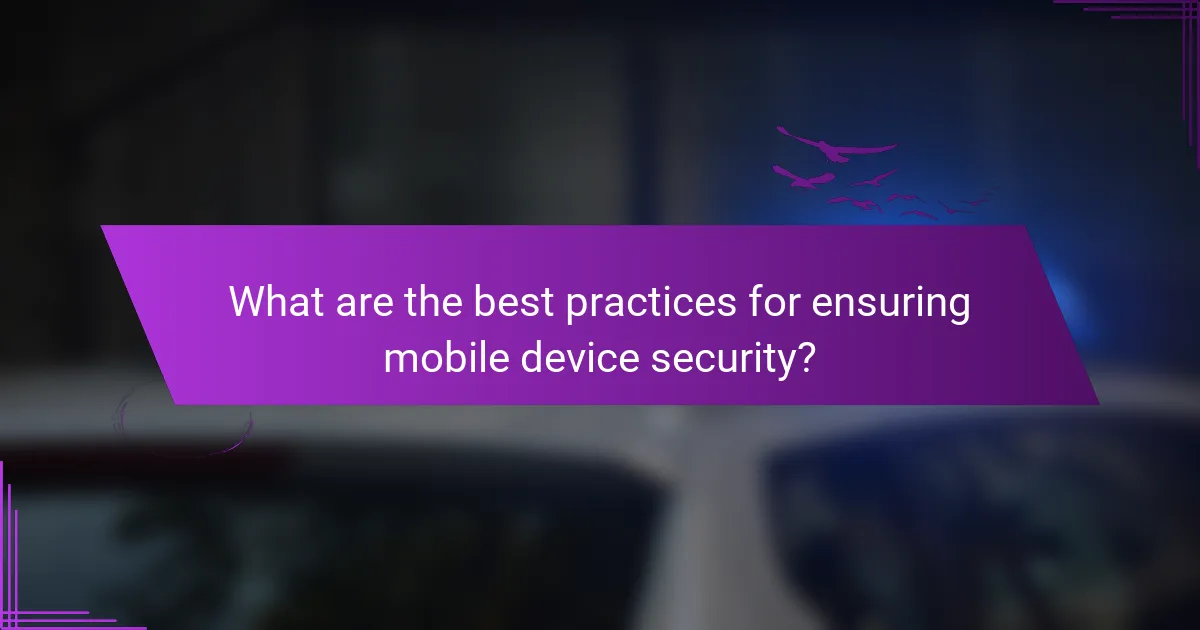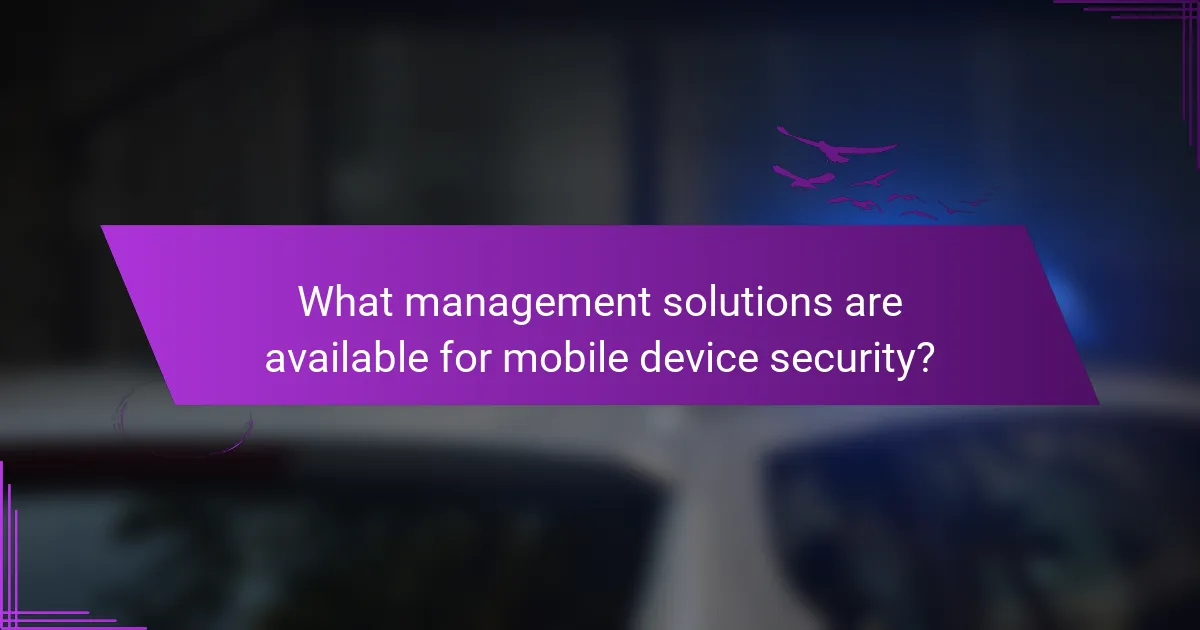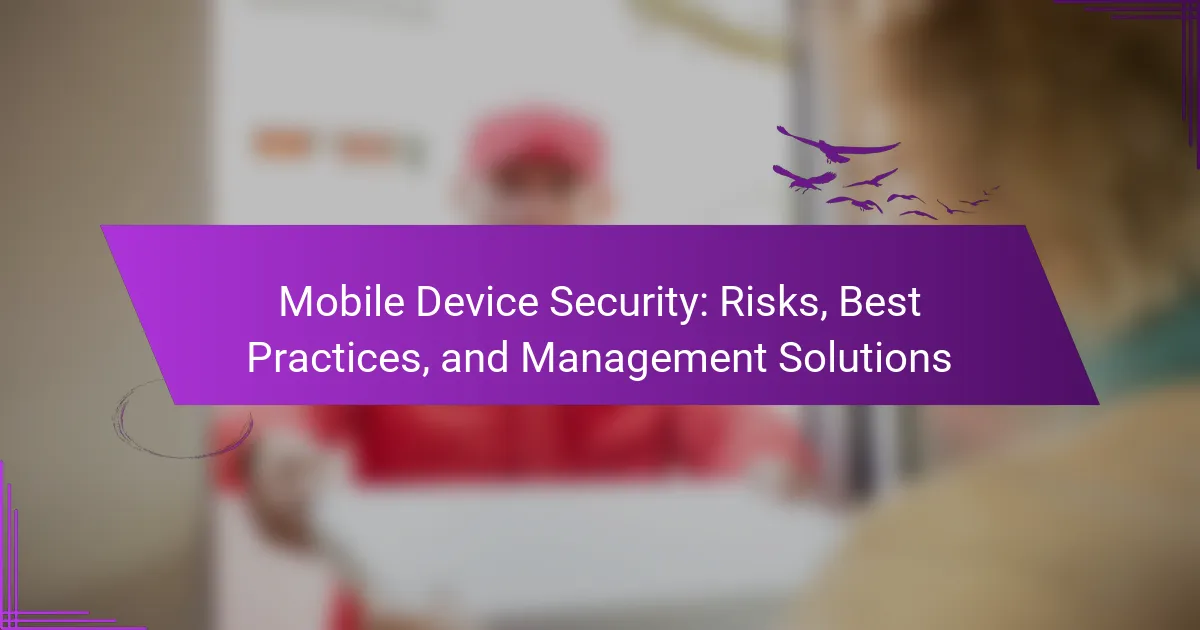
What is Mobile Device Security?
Mobile device security refers to the protection of smartphones, tablets, and other portable devices from threats such as unauthorized access, malware, and data breaches. It involves implementing measures to safeguard sensitive information stored on these devices. According to a 2022 report by the Ponemon Institute, 56% of organizations experienced a mobile data breach in the past year. Effective mobile device security includes using strong passwords, enabling encryption, and regularly updating software. These practices help mitigate risks associated with mobile threats and ensure data integrity.
Why is Mobile Device Security important in today’s digital landscape?
Mobile device security is crucial in today’s digital landscape due to the increasing reliance on mobile devices for personal and business activities. These devices store sensitive information, including financial details and personal communications. According to a report by Cybersecurity Ventures, mobile malware attacks are expected to reach 1.5 billion by 2025. This highlights the significant risk posed to users. Furthermore, mobile devices are often targets for phishing attacks, which can compromise user data. The rise of remote work has also expanded the threat landscape, making mobile security even more essential. Protecting mobile devices helps prevent data breaches and identity theft, safeguarding both individuals and organizations.
What are the key threats to mobile device security?
Key threats to mobile device security include malware, phishing attacks, and unsecured Wi-Fi networks. Malware can compromise device functionality and steal sensitive information. Phishing attacks often trick users into revealing personal data through fraudulent messages or websites. Unsecured Wi-Fi networks expose devices to interception and unauthorized access. Additionally, device loss or theft poses significant risks, as it can lead to unauthorized access to personal data. According to a report by McAfee, mobile malware attacks increased by 50% in 2020, highlighting the growing threat landscape.
How do mobile devices differ from traditional computing devices in terms of security?
Mobile devices differ from traditional computing devices in terms of security primarily due to their portability and connectivity. Mobile devices often connect to various networks, increasing exposure to potential threats. They typically lack the robust security measures found in traditional devices, such as firewalls and antivirus software. Mobile operating systems also face unique vulnerabilities, such as app-based threats.
Moreover, mobile devices frequently store sensitive data and personal information, making them attractive targets for cybercriminals. A report by Cybersecurity Ventures predicts that mobile malware attacks will increase significantly, highlighting the growing risks. Additionally, users often neglect security updates on mobile devices, further exacerbating vulnerabilities.
In contrast, traditional computing devices usually have more extensive security protocols and user controls. This difference necessitates a tailored approach to security management for mobile devices.
What are the common risks associated with mobile devices?
Common risks associated with mobile devices include malware infections, data breaches, and unauthorized access. Malware can compromise device security and lead to data loss. According to a report by McAfee, mobile malware increased by 50% in 2020. Data breaches often occur through unsecured Wi-Fi networks. A study by Verizon found that 30% of data breaches involved mobile devices. Unauthorized access can happen through weak passwords or unpatched software vulnerabilities. The same Verizon report indicated that 80% of breaches were due to compromised credentials. Phishing attacks targeting mobile users are also prevalent, with a rise in SMS phishing attempts. These risks highlight the importance of robust mobile security measures.
How can malware affect mobile devices?
Malware can affect mobile devices by compromising their security and functionality. It can lead to unauthorized access to personal data, including contacts, messages, and financial information. Malware may also cause devices to slow down or crash. Some types can drain battery life rapidly or consume excessive data. Additionally, malware can enable remote control of the device by attackers. This can facilitate further malicious activities, such as sending spam or stealing sensitive information. According to a report by McAfee, mobile malware attacks increased by 50% in 2020, highlighting the growing threat to mobile device security.
What role does network security play in mobile device risks?
Network security is crucial in mitigating mobile device risks. It protects devices from unauthorized access and cyber threats. Strong network security measures prevent data breaches and malware infections. For instance, firewalls and encryption safeguard sensitive information transmitted over networks. According to a report by Cybersecurity & Infrastructure Security Agency, 90% of cyber incidents involve network vulnerabilities. Thus, effective network security reduces the likelihood of mobile device exploitation.

What are the best practices for ensuring mobile device security?
Use strong passwords and biometric authentication to secure mobile devices. Regularly update the operating system and applications to patch vulnerabilities. Install reputable security software to detect and prevent threats. Enable remote wipe capabilities to erase data if the device is lost or stolen. Avoid connecting to unsecured Wi-Fi networks to reduce the risk of data interception. Regularly back up data to prevent loss in case of a security breach. Educate users on recognizing phishing attempts and suspicious links. These practices collectively enhance mobile device security by addressing common vulnerabilities and threats.
How can users protect their mobile devices from security threats?
Users can protect their mobile devices from security threats by implementing several key practices. First, they should regularly update their operating system and apps to patch vulnerabilities. Research shows that 60% of mobile threats exploit outdated software. Second, users must install reputable security software to detect and mitigate threats. Studies indicate that mobile security apps can reduce malware risks significantly. Third, employing strong passwords and biometric authentication adds an extra layer of security. According to a report, 80% of data breaches involve weak or stolen passwords. Fourth, users should avoid connecting to public Wi-Fi networks without a VPN, as these networks are often unsecured. Lastly, users must be cautious about downloading apps from untrusted sources, as these can harbor malware. Following these practices can substantially enhance mobile device security.
What are the essential security settings for mobile devices?
Essential security settings for mobile devices include enabling a strong passcode, activating biometric authentication, and keeping the operating system updated. A strong passcode prevents unauthorized access. Biometric authentication, such as fingerprint or [censured] recognition, adds an extra layer of security. Regular updates patch vulnerabilities in the operating system. Additionally, users should enable remote wipe capabilities to erase data if the device is lost or stolen. Installing reputable security apps can also protect against malware and other threats. Lastly, disabling unnecessary features, like Bluetooth and location services when not in use, reduces exposure to risks.
How important is software updating for mobile security?
Software updating is crucial for mobile security. Updates often include patches for vulnerabilities that hackers exploit. According to the National Cyber Security Centre, 60% of malware attacks target outdated software. Regular updates help protect against these threats. They also enhance device performance and add new features. Ignoring updates can lead to data breaches and loss of personal information. Therefore, timely software updates are essential for maintaining mobile security.
What are the best practices for organizations managing mobile devices?
Implementing a comprehensive mobile device management (MDM) strategy is essential for organizations. This includes setting clear security policies tailored to mobile devices. Organizations should enforce strong password policies and multi-factor authentication. Regular software updates and patch management are crucial for security. Employee training on mobile security awareness enhances protection against threats. Data encryption should be standard for sensitive information on mobile devices. Remote wipe capabilities are necessary to protect data in case of loss or theft. Monitoring and auditing mobile device usage helps identify potential security breaches. Finally, organizations should consider using a secure virtual private network (VPN) for remote access.
How can organizations implement a mobile device management (MDM) solution?
Organizations can implement a mobile device management (MDM) solution by following a structured approach. First, they should assess their specific needs and goals for mobile device management. This includes identifying the types of devices and operating systems used in the organization. Next, they need to choose a suitable MDM software that aligns with their requirements. Popular options include Microsoft Intune, VMware Workspace ONE, and MobileIron.
Once the software is selected, organizations should configure the MDM solution to enforce security policies and compliance requirements. This may involve setting up device enrollment processes, defining access controls, and enabling remote wipe capabilities. Training staff on the MDM system is also crucial to ensure effective usage.
After deployment, organizations should continuously monitor device compliance and security. Regular updates and patches should be applied to the MDM solution to protect against vulnerabilities. According to a report by Gartner, 70% of organizations that implemented an MDM solution reported improved mobile security and reduced data breaches.
What policies should organizations establish for mobile device use?
Organizations should establish clear mobile device use policies to ensure security and compliance. These policies should define acceptable use, including personal and professional device separation. Organizations must mandate strong password requirements and regular software updates. They should also implement remote wipe capabilities to protect sensitive data. Training employees on security best practices is essential. Organizations must enforce data encryption for sensitive information. Regular audits and monitoring of mobile device usage should be conducted. Establishing consequences for policy violations is also necessary to maintain compliance.

What management solutions are available for mobile device security?
Management solutions for mobile device security include Mobile Device Management (MDM), Mobile Application Management (MAM), and Mobile Threat Defense (MTD). MDM solutions allow organizations to manage device settings, enforce security policies, and remotely wipe devices if lost or stolen. MAM focuses on securing applications and data within those applications, providing control over app distribution and usage. MTD solutions protect devices from malware and other threats by continuously monitoring for vulnerabilities and anomalies. These solutions collectively enhance security by enabling organizations to maintain oversight and control over mobile devices in their networks.
What types of mobile device management solutions exist?
There are several types of mobile device management (MDM) solutions. These include on-premise MDM solutions, which are hosted within an organization’s own infrastructure. Cloud-based MDM solutions are hosted on external servers and accessible via the internet. Hybrid MDM solutions combine both on-premise and cloud-based elements for flexibility. Containerization solutions focus on separating corporate data from personal data on devices. Enterprise mobility management (EMM) solutions offer broader capabilities, including application management and security. Each type provides different levels of control, security, and deployment options tailored to organizational needs.
How do cloud-based MDM solutions differ from on-premises solutions?
Cloud-based MDM solutions differ from on-premises solutions primarily in deployment, maintenance, and scalability. Cloud-based solutions are hosted on remote servers and accessed via the internet. This allows for automatic updates and easier scalability as businesses can adjust their usage based on needs. In contrast, on-premises solutions require local installation and management, which can lead to higher maintenance costs and complexity.
Cloud-based MDM typically offers lower upfront costs, as there is no need for extensive hardware investment. On-premises solutions often involve significant capital expenditure for servers and infrastructure. Additionally, cloud-based MDM solutions provide enhanced accessibility, allowing administrators to manage devices from anywhere. On-premises solutions may limit access to local networks, reducing flexibility.
Security measures in cloud-based solutions are often managed by the provider, which can include advanced features like regular security audits and compliance certifications. On-premises solutions require organizations to manage their own security protocols, potentially leading to vulnerabilities if not maintained properly.
What features should organizations look for in an MDM solution?
Organizations should look for several key features in a Mobile Device Management (MDM) solution. These features include device tracking capabilities, which allow administrators to monitor the location and status of devices. Security features are crucial, such as remote wipe and lock functions to protect sensitive data. Compliance management tools help ensure that devices adhere to regulatory standards. Application management capabilities enable organizations to control app installations and updates. User access controls are essential for managing permissions and restricting access to sensitive information. Reporting and analytics features provide insights into device usage and security incidents. Integration with existing IT systems enhances the MDM solution’s effectiveness. Finally, user-friendly interfaces improve adoption and ease of use for both IT staff and end-users.
How can organizations assess the effectiveness of their mobile security measures?
Organizations can assess the effectiveness of their mobile security measures through regular security audits. These audits evaluate the security policies, controls, and practices in place. They help identify vulnerabilities and compliance with industry standards. Organizations should also implement [censured] testing to simulate attacks. This testing reveals weaknesses in the mobile security framework. Additionally, monitoring mobile device usage and access patterns can provide insights into security effectiveness. Collecting data on incidents and breaches helps evaluate response capabilities. Surveys and feedback from users can highlight areas needing improvement. Continuous training and awareness programs ensure that employees understand security protocols. Regular updates and patches to mobile security software are crucial for maintaining effectiveness.
What metrics should be used to evaluate mobile device security?
Key metrics to evaluate mobile device security include device compliance, vulnerability management, and incident response time. Device compliance measures adherence to security policies. This can be assessed by tracking the percentage of devices meeting security standards. Vulnerability management focuses on identifying and addressing security weaknesses. It is important to monitor the number of vulnerabilities discovered and resolved over time. Incident response time evaluates how quickly security incidents are addressed. This can be quantified by measuring the average time taken to respond to and mitigate security threats. Additionally, user behavior analytics can provide insights into potential security risks based on usage patterns. These metrics collectively help in assessing the overall security posture of mobile devices.
How often should organizations conduct security audits on mobile devices?
Organizations should conduct security audits on mobile devices at least annually. This frequency ensures that vulnerabilities are identified and addressed promptly. Regular audits help organizations comply with industry regulations. They also mitigate risks associated with data breaches. In addition, mobile device usage is rapidly evolving, necessitating frequent assessments. Annual audits allow organizations to adapt to new threats and technologies. Some organizations may benefit from semi-annual or quarterly audits, especially in high-risk environments. Consistent auditing enhances overall mobile security posture and protects sensitive information.
What practical tips can enhance mobile device security?
Use strong passwords and enable two-factor authentication. These measures significantly reduce unauthorized access. Regularly update your operating system and apps to fix security vulnerabilities. Install reputable security software to protect against malware and viruses. Avoid connecting to public Wi-Fi networks without a VPN, as they can expose your data. Be cautious when downloading apps; only use trusted sources like official app stores. Regularly back up your data to prevent loss in case of theft or damage. Finally, enable remote wipe capabilities to erase data if your device is lost or stolen.
Mobile device security is the practice of protecting smartphones, tablets, and other portable devices from various threats, including unauthorized access, malware, and data breaches. This article outlines the importance of mobile device security in today’s digital landscape, highlighting key threats such as malware and phishing attacks, as well as the unique security challenges mobile devices face compared to traditional computing devices. It also discusses best practices for individuals and organizations to enhance mobile security, including the implementation of strong passwords, regular software updates, and the use of mobile device management solutions. Additionally, the article emphasizes the significance of network security and provides practical tips to mitigate risks associated with mobile device usage.
